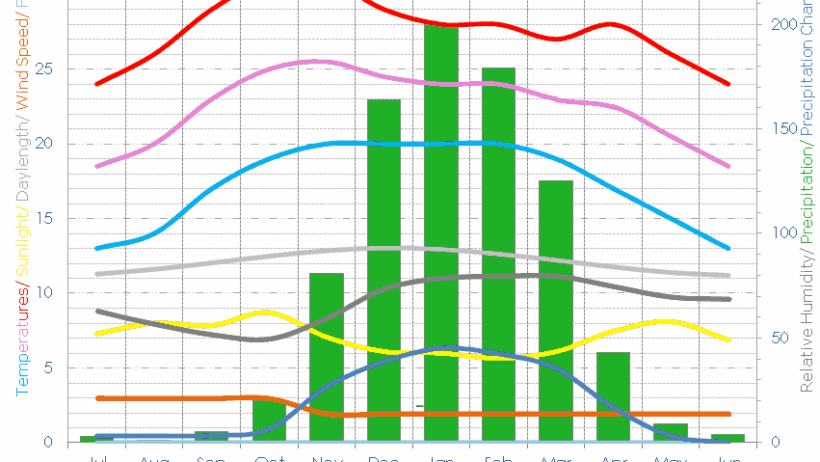Malawi, a landlocked country in southeastern Africa, epitomizes the quintessential characteristics of a warm tropical climate. This idyllic region, often celebrated for its stunning landscapes and rich biodiversity, exhibits distinct climatic patterns that are profoundly shaped by its geographic location, topography, and seasonal variations. Understanding the climate of Malawi is essential, not just for its residents, but also for those invested in environmental conservation, agriculture, and tourism.
At the heart of Malawi’s climate lies its tropical essence, characterized by languid warmth and seasonal rainfall. Situated between latitudes 9° and 17° south of the equator, it enjoys a predominantly tropical savanna climate. The warm tropics imbue the region with abundant sunshine most of the year, with average temperatures oscillating between 20°C (68°F) and 30°C (86°F). However, variations in elevation, particularly in regions like the Nyika Plateau, can lead to sporadic cooler temperatures, creating a microclimate that diverges from the overarching warmth.
Malawi’s climate can be neatly divided into three distinct seasons: the hot and dry season, the rainy season, and the cool season. The hot season typically spans from September to December, with October and November being the peak months. During this time, temperatures soar, often reaching their zenith, creating a sultry atmosphere that can be somewhat oppressive. As the meandering waters of Lake Malawi influence local weather patterns, regions closer to the lake may experience a slightly moderated temperature compared to the elevated areas.
Following the hot season, the rainy season descends upon the land, generally commencing in late November and extending into March. This is the most critical season for agriculture, as the sporadic rains feed the vast fields of maize, tobacco, and other crops that form the backbone of Malawi’s agrarian society. The rainfall itself tends to be erratic, with occurrences of heavy downpours interspersed with dry spells. This variability can pose challenges for farmers who rely on predictable weather patterns for successful harvests. On the other hand, these rain-laden months proffer a diverse tapestry of flora and fauna, fostering an environment ripe for biodiversity.
Concurrently, the region’s meteorology fluctuates significantly with altitude. The highlands of the northern and central regions of Malawi, such as the Nyika and Livingstonia, experience cooler and wetter conditions than the drier lowland areas in the southern part of the country. This variability creates unique ecosystems that are home to various endemic species, particularly in protected areas like Nyika National Park, where misty montane forests flourish.
As the rainy season wanes, Malawi transitions into its cool season from May to August. During this period, temperatures decline, offering a respite from the sweltering heat. The days are pleasantly warm, while nights can dip to around 10°C (50°F), particularly in elevated regions, necessitating warmer clothing. This time of year is not only enjoyable for inhabitants but is also conducive to outdoor activities, attracting both local and international tourists eager to explore the natural beauty of Malawi.
It is imperative to note the increasing impact of climate change on Malawi’s weather patterns. The unpredictability of rainfall has heightened, making it increasingly difficult for farmers to determine optimal planting times. Moreover, intensified droughts and flooding have been observed, posing severe challenges to food security and economic stability in a country heavily reliant on agriculture. Such environmental perturbations exacerbate existing vulnerabilities, particularly among marginalized communities that lack the resources to adapt to changing climatic conditions.
In addition to the immediate ramifications of climate variability, Malawi is witnessing a gradual increase in average temperatures. This phenomenon poses long-term threats to both human and ecological systems. The rise in temperatures can affect not just crop yields but also water availability, which is crucial for both agricultural and domestic use. Such shifts necessitate innovative adaptation strategies that allow resilience against the vicissitudes of climate change.
Despite these adversities, efforts are underway to mitigate climate impacts and bolster sustainability. Initiatives focusing on reforestation and sustainable agriculture practices are pivotal in combating the detrimental effects of deforestation and soil degradation. Embracing agroforestry, which integrates trees into agricultural systems, can enhance biodiversity and improve soil health while supporting local livelihoods. Education and community engagement play crucial roles in fostering an understanding of sustainable practices, ensuring the survival of both the environment and the local populace.
In conclusion, the climate of Malawi is a mosaic of warm tropical conditions intermixed with seasonal rainfall, profoundly influencing the nation’s agricultural practices and ecological systems. As the nation grapples with the realities of climate change, understanding and adapting to its climatic patterns becomes imperative. By fostering resilience through sustainable practices and enhancing awareness, Malawi can navigate the challenges posed by a changing climate, ensuring a viable future for its environment and inhabitants alike.








